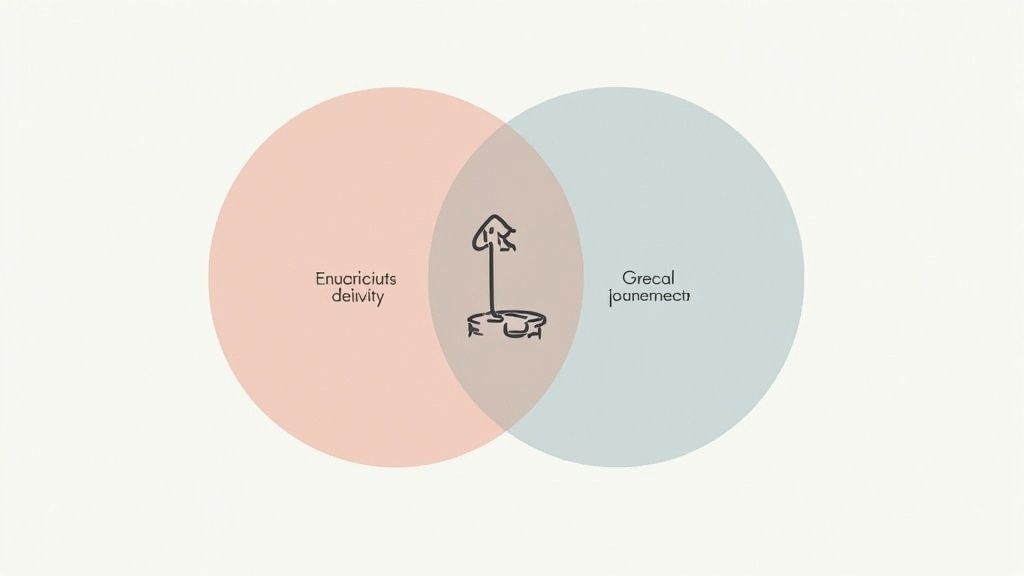Every powerful essay is built on a strong foundation, and that foundation is the thesis statement. It's the single sentence that guides your argument, focuses your research, and tells the reader exactly what to expect. Think of it as the North Star for your paper; without a clear, well-crafted thesis, even the most brilliant ideas can become lost and your argument can feel unfocused. This guide moves beyond simple definitions to provide concrete thesis statement examples across eight distinct categories, from argumentative to narrative.
We'll break down not just what makes these examples work, but how you can replicate their success. Each example comes with a strategic analysis and actionable takeaways you can apply to your own writing immediately. To ensure your thesis acts as a true 'North Star,' exploring masterful book introduction examples can provide insights into effectively setting the stage for your argument from the very first sentence.
Our goal is to give you the tactical insights needed to construct a compelling thesis for any subject or assignment. By understanding the mechanics behind a powerful thesis, you can elevate your essays from good to great, ensuring your message is clear, persuasive, and impactful.
1. Argumentative Thesis Statement
An argumentative thesis statement is the cornerstone of any persuasive essay. It presents a clear, debatable claim and outlines the primary reasons you will use to support that claim. Its purpose is to take a definitive stance on an issue, signaling to the reader that you intend to persuade them of your viewpoint through logical reasoning and evidence. This type of thesis is not a statement of fact but a specific, arguable assertion that invites discussion and requires defense.
A strong argumentative thesis acts as a roadmap for your entire paper. It tells the reader what you are arguing and how you will prove it, creating a focused and coherent structure. This is one of the most common and powerful thesis statement examples because it forces the writer to engage critically with a topic and build a well-supported case.

Example and Analysis
Here's an excellent example of an argumentative thesis statement:
Thesis Example: "The death penalty should be abolished in all states because it does not deter crime, costs taxpayers more than life imprisonment, and risks the irreversible execution of innocent people."
Strategic Breakdown:
- Clear Position: The statement begins with a non-negotiable claim: "The death penalty should be abolished." There is no ambiguity about the author's stance.
- Specific Reasons (The "Because" Clause): It provides three distinct, provable points that will form the body paragraphs of the essay: (1) it fails to deter crime, (2) it is more expensive, and (3) it risks executing the innocent.
- Debatable Nature: This topic is highly debatable, with strong arguments on both sides. This makes it a perfect fit for a persuasive essay.
Actionable Takeaways
To craft your own powerful argumentative thesis, follow these strategic steps:
- Start with a Question: Begin by asking a "why" or "how" question about a debatable topic. For instance, "Why should social media platforms be regulated?"
- Formulate a Claim: Answer your question with a strong, declarative sentence that states your position. "Social media platforms should be regulated by the government."
- Add Your Pillars: Support your claim with at least three main reasons. These will become the core evidence for your paper. Combine them into a single sentence using a "because" clause.
This approach ensures your thesis is not only argumentative but also provides a clear, logical structure for your entire essay, making your writing process more efficient and your argument more convincing.
2. Analytical Thesis Statement
An analytical thesis statement does not argue for or against a topic; instead, it breaks down a complex issue, text, or phenomenon into its essential components. It then examines how these parts interact to create a larger effect or meaning. Its purpose is to present an interpretation or a framework for understanding, guiding the reader through a detailed examination of how something works. This type of thesis makes a claim about how or why something is the way it is, rather than stating a simple fact.
A strong analytical thesis provides a lens through which the reader can view the subject matter. It sets up an exploratory journey, promising to reveal the inner workings of a topic. This is a crucial skill in academic writing, making analytical thesis statement examples essential for anyone looking to deepen their understanding of literary works, historical events, or business strategies. You can explore this further in this academic writing style guide.

Example and Analysis
Here is a classic example of an analytical thesis statement from literary studies:
Thesis Example: "In 1984, George Orwell demonstrates how totalitarian governments maintain power by systematically controlling language through Newspeak, manipulating thought via doublethink, and enforcing constant surveillance."
Strategic Breakdown:
- Identifies the Subject and Author: The statement clearly names the text (1984) and its author (George Orwell).
- Makes an Interpretive Claim: It asserts how the government in the novel maintains power, which is an interpretation, not just a plot summary.
- Specifies Analytical Components: It lists the three key mechanisms that will be analyzed in the body paragraphs: (1) Newspeak, (2) doublethink, and (3) surveillance.
- Focuses on "How": The entire statement is built around explaining the process and methods used within the novel's world.
Actionable Takeaways
To build your own insightful analytical thesis, use these strategic steps:
- Ask an Analytical Question: Start by asking "How?" or "Why?" about your topic. For instance, "How does Starbucks succeed globally?"
- Identify Key Components: Break down the subject into its most important parts. For Starbucks, this might be cultural adaptation, brand consistency, and digital marketing.
- Formulate a Thesis: Combine your subject, claim, and components into a single, focused sentence. "The success of Starbucks' global expansion can be attributed to its strategic cultural adaptation, consistent brand experience, and innovative digital marketing."
This method ensures your thesis provides a clear roadmap for your analysis, allowing you to explore a topic with depth, precision, and a coherent structure.
3. Expository Thesis Statement
An expository thesis statement serves as a guide for an informative essay. Unlike an argumentative thesis, it does not present a debatable claim or try to persuade the reader. Instead, its primary function is to explain, describe, or inform the audience about a specific topic by presenting factual information in a clear and organized manner. It declares the main topic and outlines the key aspects that will be discussed.
This type of thesis is crucial for essays that aim to educate. It promises the reader a logical and straightforward exploration of a subject, ensuring they know exactly what information the paper will cover. As one of the foundational thesis statement examples, the expository thesis helps writers distill complex topics into manageable, understandable components, making it an essential tool for clear communication.

Example and Analysis
Here is a classic example of an expository thesis statement:
Thesis Example: "The process of photosynthesis involves three main stages: light absorption, carbon dioxide fixation, and glucose production, which together enable plants to convert sunlight into usable energy."
Strategic Breakdown:
- Clear Topic: The statement clearly identifies the topic: "The process of photosynthesis."
- Specific Subtopics (The "Blueprint"): It outlines the exact parts of the process that will be explained: (1) light absorption, (2) carbon dioxide fixation, and (3) glucose production. These will become the body paragraphs.
- Informative Purpose: The goal is purely to inform. It doesn't argue whether photosynthesis is good or bad; it simply explains how it works.
Actionable Takeaways
To write your own effective expository thesis, follow these strategic steps:
- Identify Your Topic: Choose a subject you want to explain. For example, "the causes of the Great Depression."
- Select Key Aspects: Break down the topic into its most important components or stages. For the Great Depression, this could be the stock market crash, bank failures, and widespread unemployment.
- Combine into a Statement: Form a single, concise sentence that introduces the topic and lists the key aspects you will cover. This creates a clear roadmap for your reader.
This method ensures your thesis is focused, comprehensive, and perfectly suited for an informative essay, guiding both you and your reader through the subject matter logically.
4. Compare and Contrast Thesis Statement
A compare and contrast thesis statement sets the stage for an essay that examines two or more subjects, highlighting their similarities and differences. Its primary function is to establish a clear purpose for the comparison, guiding the reader by indicating whether the essay will focus on similarities, differences, or a combination of both. This type of thesis moves beyond simple observation to argue for a particular insight or judgment that arises from the comparison.
This thesis structure is fundamental for essays that require critical analysis of multiple viewpoints, theories, or objects. By forcing a writer to identify specific points of comparison, it ensures a balanced and well-organized argument. These are excellent thesis statement examples for developing analytical skills, as they require you to look at subjects from a new perspective to reveal meaningful connections or distinctions.

Example and Analysis
Here is a strong example of a compare and contrast thesis statement:
Thesis Example: "While both online and traditional education provide valuable learning opportunities, online education offers superior flexibility and accessibility, whereas traditional education fosters more effective direct interaction and hands-on engagement."
Strategic Breakdown:
- Acknowledges Similarity: The statement begins by acknowledging a common ground ("provide valuable learning opportunities"), which sets a fair tone.
- Highlights Key Differences: It clearly outlines the specific points of contrast that will be explored. Online education is framed by its "flexibility and accessibility," while traditional education is defined by "direct interaction and hands-on engagement."
- Establishes a Purpose: The thesis doesn’t just list differences; it implicitly argues that the choice between the two depends on a student's priorities, suggesting a nuanced conclusion rather than declaring one as definitively better overall.
Actionable Takeaways
To build an effective compare and contrast thesis, use these strategic steps:
- Choose Meaningful Subjects: Select two subjects that have a logical basis for comparison. Comparing a car and a bicycle is more effective than comparing a car and a tree.
- Identify a Central Tension: Don't just list similarities and differences. Find a core tension or an interesting insight that your comparison reveals. Ask yourself, "So what?" Why does this comparison matter?
- Use Signal Words: Employ comparative language like "while," "whereas," "although," or "on the other hand" to clearly signal the relationship between your subjects and create a balanced structure.
This method helps you move beyond a simple list of facts and construct an essay that offers a genuine, analytical insight based on a structured comparison.
5. Cause and Effect Thesis Statement
A cause and effect thesis statement is designed to establish a clear relationship between events or phenomena. It identifies one or more specific causes and outlines the resulting effects, or conversely, examines the multiple causes behind a particular effect. This type of thesis serves as the foundation for an essay that analyzes the "why" and "what happened next" of a situation, making it ideal for exploring historical events, social trends, or scientific outcomes.
The goal is to move beyond simple correlation and argue for a direct causal link. A strong cause and effect thesis clearly states the relationship being examined, providing a focused argument that guides the entire paper. These are powerful thesis statement examples because they require critical thinking about connections and consequences, leading to a deeply analytical essay. For more information on how this thesis shapes your paper, you can explore various essay structure examples.
Example and Analysis
Here is a clear example of a cause and effect thesis statement:
Thesis Example: "Excessive social media use among teenagers directly causes decreased face-to-face social skills, heightened levels of anxiety and depression, and disrupted sleep patterns."
Strategic Breakdown:
- Identifies a Clear Cause: The statement pinpoints a single, specific cause: "Excessive social media use among teenagers."
- Outlines Specific Effects: It lists three distinct and measurable effects that will be proven in the body paragraphs: (1) decreased social skills, (2) increased anxiety and depression, and (3) disrupted sleep patterns.
- Asserts Causation: The use of the word "causes" establishes a strong, arguable claim of a direct link, which the essay must then support with evidence.
Actionable Takeaways
To build an effective cause and effect thesis, use these strategic steps:
- Identify a Relationship: Start by thinking about a phenomenon and ask, "What caused this?" or "What are the effects of this?" For instance, "What are the effects of the rise of remote work?"
- Focus on Significance: Choose the most significant causes or effects to analyze. Avoid trying to cover every possible angle, which can weaken your argument.
- Use Causal Language: Employ precise words like "causes," "leads to," "results in," or "is the effect of" to make the relationship explicit. This clarifies your stance and provides a solid foundation for your analysis.
This method ensures your thesis not only explains a relationship but also creates a well-organized structure for your essay, allowing you to logically connect evidence to your central claim.
6. Definition Thesis Statement
A definition thesis statement introduces an essay that aims to provide an extended, nuanced definition of a complex or abstract term. It moves beyond a simple dictionary definition to explore the term's deeper meanings, connotations, and significance within a specific context. This type of thesis argues for a particular interpretation of a concept, often challenging conventional understandings or highlighting overlooked aspects.
Its purpose is to unpack a term that is either widely misunderstood, contested, or too complex for a simple explanation. By dedicating an entire essay to defining a concept like "true leadership" or "digital literacy," the writer can explore its multifaceted nature in detail. These thesis statement examples are crucial for papers that seek to clarify and reframe a reader's perspective on a foundational idea.
Example and Analysis
Here is a strong example of a definition thesis statement:
Thesis Example: "True leadership is not about holding authority or making decisions, but about inspiring others, fostering collaboration, and creating positive change through emotional intelligence and ethical behavior."
Strategic Breakdown:
- Negation and Affirmation: The statement first defines what leadership is not ("not about holding authority") before asserting what it is. This immediately sets up a comparison and clarifies the essay's focus.
- Component Parts: It breaks the definition down into three actionable components: (1) inspiring others, (2) fostering collaboration, and (3) creating positive change. These will guide the body paragraphs.
- Qualifying Concepts: It adds layers of complexity by introducing "emotional intelligence and ethical behavior" as the mechanisms through which true leadership is achieved, providing further avenues for exploration.
Actionable Takeaways
To write a compelling definition thesis, use these strategic steps:
- Choose a Complex Term: Select a word or concept that is abstract, subjective, or has multiple meanings (e.g., "success," "freedom," "community"). Avoid terms with simple, universally accepted definitions.
- Establish a Framework: Decide how you will define the term. Will you define it by its function, by what it is not (negation), or by comparing it to other concepts?
- Identify Key Characteristics: Break your proposed definition into several distinct characteristics or criteria. These will become the main points of your essay, giving your definition substance and structure.
This method helps you move past a surface-level explanation, allowing you to construct a sophisticated argument for a particular understanding of a complex term and demonstrate your own critical thinking.
7. Problem-Solution Thesis Statement
A problem-solution thesis statement identifies a significant issue and proposes a clear, actionable plan to resolve it. This type of thesis is crucial for persuasive essays, policy papers, and proposals, as it moves beyond simply analyzing a problem to advocating for a specific course of action. It demonstrates critical thinking by not only diagnosing an issue but also by formulating a practical and well-reasoned remedy.
The function of a problem-solution thesis is to frame your entire paper as a response to a pressing need. It signals to the reader that you will first establish the severity of a problem and then dedicate the body of your work to proving why your proposed solution is the most effective. This makes it one of the most practical thesis statement examples for writing that aims to influence real-world change.
Example and Analysis
Here is a strong example of a problem-solution thesis statement:
Thesis Example: "To combat the rising rates of urban youth unemployment, cities must implement a three-pronged strategy: expanding vocational training programs in high schools, creating subsidized internship partnerships with local businesses, and launching mentorship networks to connect young adults with industry professionals."
Strategic Breakdown:
- Identified Problem: The thesis clearly names the issue: "rising rates of urban youth unemployment." This is a specific and significant problem.
- Proposed Solution: It outlines a comprehensive, multi-part solution instead of a single, simplistic fix. This adds credibility and depth to the argument.
- Action-Oriented Language: The use of action verbs like "implement," "expanding," "creating," and "launching" makes the proposed solution feel concrete and achievable.
- Clear Structure: The three prongs of the strategy directly map out the main sections of the paper, providing a logical flow for the argument. This structure is essential when developing your research paper outline.
Actionable Takeaways
To construct an effective problem-solution thesis, use these strategic steps:
- Define a Specific Problem: Don't just say "pollution is bad." Instead, focus on a manageable aspect, like "plastic waste in local waterways." Ensure you can prove the problem's significance with evidence.
- Brainstorm Realistic Solutions: Propose solutions that are practical and implementable. Consider potential costs, logistics, and stakeholder buy-in. Avoid overly idealistic or vague ideas.
- Connect Problem to Solution: Use clear transitional language ("To address X, we must do Y") to explicitly link your proposed solution to the problem you've identified. This creates a powerful, cause-and-effect framework for your essay.
8. Narrative Thesis Statement
A narrative thesis statement establishes the central theme or significance of a personal story. Unlike an argumentative thesis that makes a debatable claim, a narrative thesis previews the insight or lesson the author learned from a specific experience. It acts as a promise to the reader, indicating that the story to follow is not just a sequence of events but a meaningful journey with a clear takeaway.
This type of thesis transforms a simple anecdote into a compelling narrative essay. It provides purpose and direction, ensuring the story’s details all contribute to illustrating a larger point about personal growth, human nature, or a particular lesson learned. For writers crafting personal essays or college applications, mastering these thesis statement examples is key to connecting a personal experience to a universal theme.
Example and Analysis
Here's an excellent example of a narrative thesis statement:
Thesis Example: "Through my struggle with social anxiety during my first year of college, I discovered that personal growth often requires stepping outside my comfort zone and that perceived weaknesses can become unexpected sources of strength and empathy."
Strategic Breakdown:
- Sets the Scene: The thesis immediately establishes the context: "my struggle with social anxiety during my first year of college." This grounds the reader in a specific time and challenge.
- Identifies the Insight (The "Discovery"): It clearly states the lesson learned: personal growth requires discomfort, and weaknesses can become strengths. This is the story's main point.
- Universal Theme: The lesson connects a personal struggle to broader, relatable themes of growth, strength, and empathy, making the story relevant to a wider audience.
Actionable Takeaways
To craft your own compelling narrative thesis, follow these strategic steps:
- Reflect on the "So What?": Start by asking what your experience truly taught you. What is the single most important lesson or change you underwent?
- Pinpoint the Core Conflict: Identify the central challenge or event that sparked this lesson. Was it a specific failure, a relationship, or an internal battle?
- Connect the Story to the Lesson: Formulate a sentence that links the experience (the story's setup) to the insight (the story's purpose). Use phrases like "My experience taught me...," "Through this, I learned...," or "I discovered that..." to bridge the two parts.
This method ensures your narrative has a clear purpose from the start, guiding both your writing and your reader's understanding of the story’s significance.
Thesis Statement Types Comparison Table
| Thesis Statement Type | 🔄 Implementation Complexity | ⚡ Resource Requirements | 📊 Expected Outcomes | 💡 Ideal Use Cases | ⭐ Key Advantages |
|---|---|---|---|---|---|
| Argumentative Thesis Statement | Moderate to high; requires clear, defendable stance | Requires substantial evidence and research | Clear position that guides persuasive arguments | Persuasive essays, debates, opinion pieces | Provides clear direction; engages readers |
| Analytical Thesis Statement | High; involves breaking down components and analyzing relationships | Requires strong analytical skills and thorough research | Deep, nuanced understanding and critical insights | Literary analysis, academic research, policy papers | Demonstrates critical thinking; allows nuance |
| Expository Thesis Statement | Low to moderate; focuses on explaining facts clearly | Requires reliable factual sources | Informative, clear explanation of a topic | Educational content, how-to guides, scientific writing | Easier research; broadly accepted; educational |
| Compare and Contrast Thesis Statement | Moderate; needs balanced comparison framework | Requires relevant data on multiple subjects | Balanced understanding of similarities and differences | Essays comparing concepts, products, ideas | Clear organization; facilitates critical thinking |
| Cause and Effect Thesis Statement | Moderate to high; establishing causality can be complex | Requires credible sources to prove causation | Logical explanation of causes and consequences | Historical analysis, social sciences, policy analysis | Clarifies relationships; supports analytical thinking |
| Definition Thesis Statement | Moderate; involves extended, multi-dimensional definition | May require diverse examples and contexts | Clear understanding of complex terms or concepts | Concept exploration, theoretical papers | Clarifies abstract concepts; allows creativity |
| Problem-Solution Thesis Statement | Moderate to high; identifying problems and viable solutions | Extensive research and feasibility analysis needed | Practical proposals aimed at real-world issues | Policy proposals, grant applications, persuasive essays | Addresses issues directly; inspires action |
| Narrative Thesis Statement | Low to moderate; centers on personal experience with thematic focus | Requires personal reflection and storytelling | Emotional engagement with broader life lessons | Personal essays, memoirs, college application essays | Engages readers emotionally; allows creativity |
Putting Your Thesis to Work: From Blueprint to Final Draft
We've journeyed through a comprehensive collection of thesis statement examples, dissecting the unique mechanics behind argumentative, analytical, narrative, and many other forms. The critical lesson learned is that a thesis is never just a sentence to check off a rubric. It is the architectural blueprint for your entire paper, the central pillar that supports every argument, piece of evidence, and concluding thought.
A powerful thesis statement acts as your compass, ensuring you never get lost in the weeds of your research or the complexity of your ideas. It transforms a scattered collection of thoughts into a focused, coherent, and persuasive piece of writing. The examples in this guide demonstrate that specificity, clarity, and purpose are the universal ingredients for success, regardless of the essay type.
From Theory to Practice: Your Actionable Next Steps
Mastering the art of the thesis statement is a process of refinement. It’s about moving from a general idea to a laser-focused claim. As you begin your next writing project, use the strategies from this article as your guide.
- Step 1: Draft a "Working" Thesis: Don't aim for perfection on the first try. Start with a broad statement that captures your initial idea. For example, "Social media has an effect on society."
- Step 2: Apply the "So What?" Test: Ask yourself why your claim matters. What are the implications? Answering this question pushes you toward a more significant argument. "Social media's effect on society is significant because it alters how people form political opinions."
- Step 3: Refine for Specificity: Narrow your focus. Who, what, where, when, and how? Instead of "social media," specify a platform. Instead of "people," define a demographic. This leads to a much stronger claim: "The algorithm-driven content on TikTok significantly polarizes political discourse among users aged 18-24 by creating ideological echo chambers."
- Step 4: Make It Your North Star: Once you have a strong thesis, treat it as a contract with your reader. Every paragraph, every sentence, and every piece of data you present must directly serve to prove or explore that central claim. If a section doesn't support your thesis, it needs to be revised or removed.
The True Value of a Mastered Thesis
Beyond the immediate goal of a better grade, developing this skill has a profound impact. Crafting a strong thesis teaches you how to think critically, organize complex information, and communicate a core message with precision and power. These are not just academic skills; they are foundational abilities for any career that requires clear communication, from marketing and business to law and research.
The journey from a vague concept to a sharp, debatable, and defensible thesis is where true intellectual work happens. It's the moment you transition from being a consumer of information to a producer of knowledge. By embracing the challenge of building excellent thesis statement examples of your own, you are training your mind to be more analytical, strategic, and ultimately, more persuasive. Let this guide be your reference, but let your own curiosity and critical thinking be your engine.
Ready to transform your rough ideas into polished, powerful thesis statements? TextSpell can be your co-pilot in the writing process. Use its advanced AI to brainstorm potential arguments, refine your wording for clarity, and ensure your final thesis is strong and compelling. Start crafting your best work today with TextSpell.

